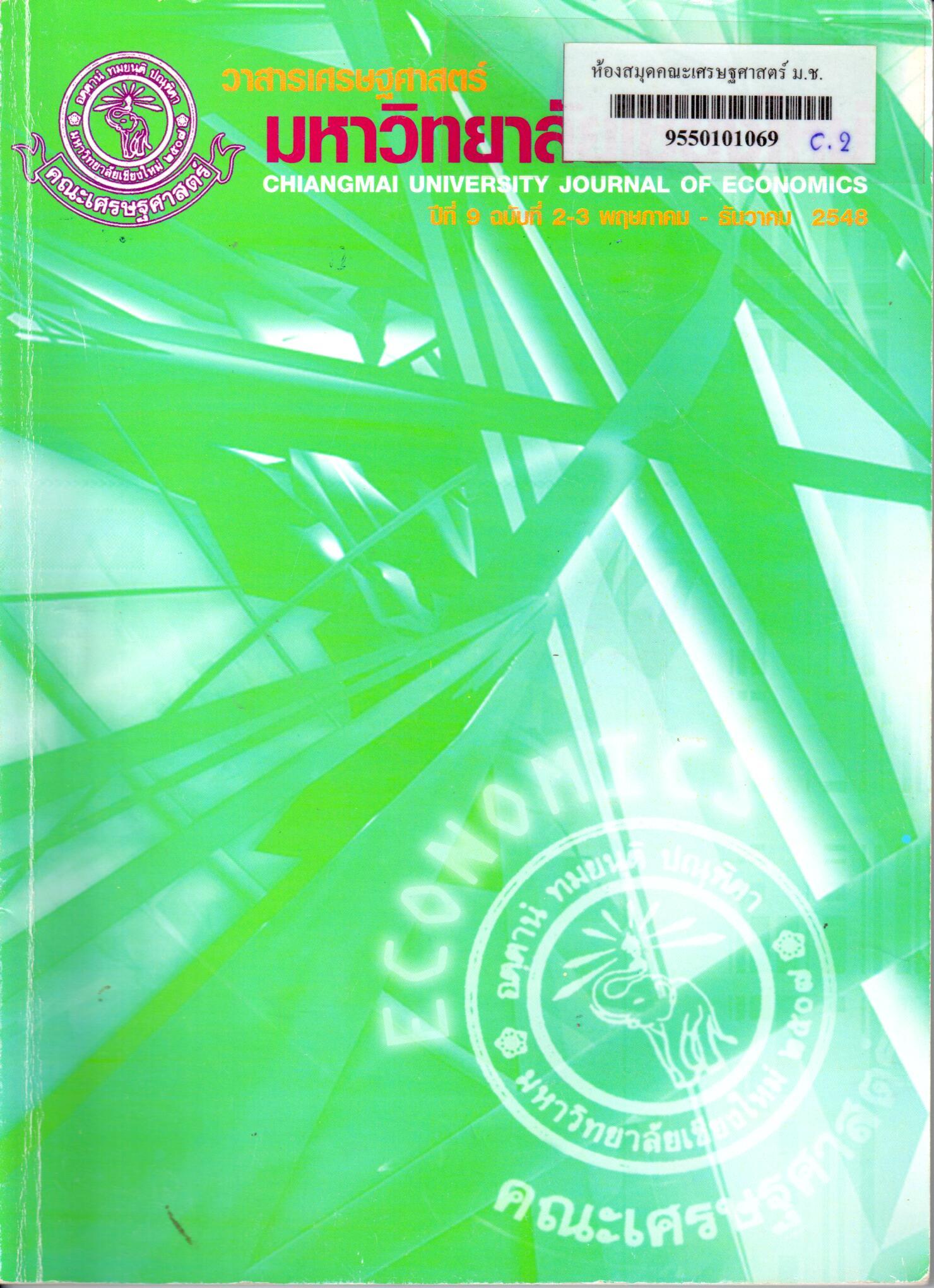แบบจำลองทางการเงินสำหรับการกำหนดอัตราแลกเปลี่ยนเงินตราต่างประเทศของไทย
Abstract
บทคัดย่อ
การศึกษานี้มีวัตถุประสงค์เพื่อที่จะศึกษาถึงปัจจัยทางเศรษฐกิจที่มีผลต่อการกำหนดดุลยภาพในระยะยาวและการปรับตัวของอัตราแลกเปลี่ยนเงินตราต่างประเทศทั้ง 6 ชนิดในระบบอัตราแลกเปลี่ยนแบบลอยตัวภายใต้การจัดการของประเทศไทย ได้แก่ อัตราการแลกเปลี่ยนบาทต่อดอลลาร์สหรัฐอเมริกา อัตราการแลกเปลี่ยนบาทต่อปอนด์เสเตอร์ลิง อัตราแลกเปลี่ยนบาทต่อ 100 เยน อัตราแลกเปลี่ยนบาทต่อดอลลาร์สิงคโปร์ อัตราแลกเปลี่ยนบาทต่อริงกิต และอัตราแลกเปลี่ยนบาทต่อดอลลาร์ฮ่องกง โดยได้ประยุกต์ใช้เทคนิคโคอินทิเกรชันและแบบจำลองเอเรอร์คอร์เรคชัน (Cointegration and Error Collection Model) มาวิเคราะห์ภายใต้แบบจำลองทางการเงินคือแบบจำลองผลต่างอัตราดอกเบี้ยที่แท้จริง (Real Interest Differential Model) สำหรับข้อมูลที่นำมาศึกษาใช้เป็นข้อมูลอนุกรมเวลารายเดือน ตั้งแต่เดือนกรกฎาคม 2540 จนถึงเดือนธันวาคม 2546 รวมทั้งสิ้น 78 ตัวอย่าง
เนื่องจากข้อมูลที่ใช้เป็นข้อมูลอนุกรมเวลา ดังนั้น จึงทำการทดสอบคุณสมบัติความนิ่งของข้อมูล(Stationary) สำหรับ ตัวแปรทุกตัว ได้แก่ อัตราแลกเปลี่ยนปริมาณเงินโดยเปรียบเทียบ ระดับรายได้โดยเปรียบเทียบ ผลต่างอัตราดอกเบี้ยระยะสั้น และอัตราเงินเฟ้อที่คาดการณ์โดยเปรียบเทียบ โดยวิธี Unit Root Test ผลการทดสอบ ปรากฏว่า ตัวแปรทุกตัวที่ใช้ในแบบจำลองทางการเงินทุกกรณีมีลักษณะไม่นิ่ง (Nonstationary) และมีอันดับความสัมพันธ์ของข้อมูลในอันดับที่ 1 ดังนั้น ดังนั้น จึงไม่สามารถนำไปวิเคราะห์หาความสัมพันธ์เชิงดุลยภาพระยะยาวระหว่างอัตราแลกเปลี่ยนและตัวแปรทางด้านเศรษฐกิจต่างๆ ในแบบจำลองโดยใช้วิธีทดสอบครูอินทีเกรชั่นของ Johansen and Juselius ผลการศึกษาพบว่า มีความสัมพันธ์เชิงดุลยภาพระยะยาวระหว่างอัตราแลกเปลี่ยนและตัวแปรทางด้านเศรษฐกิจในแบบจำลองในทุกกรณีที่ทำการทดสอบและเป็นไปตามสมมติฐานของแบบจำลองผลต่างอัตราดอกเบี้ยที่แท้จริง ยกเว้น กรณีอัตราแลกเปลี่ยนบาทต่อริงกิตที่พบว่าทิศทางความสัมพันธ์ระหว่างอัตราการแลกเปลี่ยนและอัตราดอกเบี้ยไม่เป็นไปตามสมมติฐานของแบบจำลองผลต่างอัตราดอกเบี้ยที่แท้จริงที่ใช้ในการศึกษาครั้งนี้ นอกจากนี้ยังพบว่า ตัวแปรปริมาณเงินโดยเปรียบเทียบและอัตราเงินเฟ้อที่คาดการณ์โดยเปรียบเทียบมีอิทธิพลในการกำหนดอัตราแลกเปลี่ยนเงินตราต่างประเทศมากที่สุดในทุกกรณี
สำหรับการประมาณแบบจำลองเอเรอร์คอร์เรคชัน อธิบายกลไกการปรับตัวในระยะสั้นของอัตราแลกเปลี่ยน เพื่อให้ปรับตัวเข้าสู่ระยะภาพระยะยาวพบว่า การเปลี่ยนแปลงของอัตราแลกเปลี่ยนเพื่อให้เข้าสู่ ค่าดุลยภาพในระยะยาวนั้นขึ้นอยู่กับการเปลี่ยนแปลงของตัวแปรต่างๆ ในเดือนที่ผ่านมา เป็นที่น่าสังเกตว่า ในกรณีของอัตราแลกเปลี่ยนบาทต่อริงกิตจะได้รับผลของการเปลี่ยนแปลงตัวแปรต่างๆในช่วง 2 เดือนที่ผ่านมาด้วย การปรับตัวของอัตราแลกเปลี่ยนในทุกกรณีนอกจากนี้จะขึ้นอยู่กับการเปลี่ยนแปลงของตัวแปรต่างๆดังกล่าวแล้ว การปรับตัวของอัตราแลกเปลี่ยนยังขึ้นอยู่กับค่าความเบี่ยงเบนออกจากด้วยนะภาพในเดือนที่ผ่านมา โดยส่วนที่เบี่ยงเบนออกจากดุลยภาพน้ำจะลดลงเรื่อยเรื่อย ในแต่ละช่วงเวลา พบว่า ค่าความเร็วในการปรับตัวในยะสั้นในกรณีอัตราแลกเปลี่ยนบาทต่อดอลลาร์สหรัฐ มีค่ามากที่สุด รองลงมาคืออัตราแลกเปลี่ยนบาทต่อ 100 เยน อัตราแลกเปลี่ยนบาทต่อดอลลาร์สิงคโปร์ อัตราแลกเปลี่ยนบาทต่อดอลลาร์ฮ่องกง อัตราแลกเปลี่ยนบาทต่อริงกิต และอัตราแลกเปลี่ยนบาทต่อปอนด์สเตอร์ลิงตามลำดับ
Abstract
The purpose of this study was to attempt to identify the economic factors which related to long-run equilibrium and exchange rates adjustment. This study focused on six Thai foreign bilateral exchange rates; the Baht-US Dollar, the Baht-Pounds, the Baht-100 Yen, the Baht-Singapore Dollar, the Baht-Ringgit and the Baht- Hong Kong Dollar. This study employed the Cointegration and Error Correction Model, namely Real Interest Differential Model. The 78 observations of monthly data from July 1997 to December 2003 were used in the study.
According to using time series data, it was important to investigate stationary property of all variables using unit root test. The results revealed that all series were found to be stationary at the first order of integration. In addition, the Johansen and Juselius Cointegration procedure was utilized to test the long-run relationship between the exchange rates and economic factors. The Cointegration test results substantially supported the interpretation of the real interest differential model as describing a long-run equilibrium relationship between the exchange rates and the relevant variables, except for the Baht-Ringgit case. In that case, the short-run interest rate coefficient had not anticipated sign. Also, the results detected that the relative money supply and the expected rate of inflation differential were the main factors influencing all of exchange rates.
Furthermore, this study applied the error correction model to combine the short-run effects and the adjustment process through the long-run equilibrium relationship between the exchange rates and economic factors in a single model. The results indicated that the change of exchange rates were dependent on the change of one lagged variables, expect for the Baht-Ringgit case. In that case, the change of exchange rate was relied on both the change of one period lagged and two period lagged variables. The empirical evidences also revealed that the exchange rates did not only respond to the changes in macroeconomic variables such as relative money supply, relative real income, short-run interest rate differential and expected rate of inflation differential, but also to the “disequilibrium errors” in the previous period. For the speed of adjustment coefficients of the Baht-US Dollar, the Baht-100 Yen, the Baht-Singapore Dollar, the Baht-Hong Kong Dollar the Baht-Ringgit, and the Baht-Pounds were 0.0833, 0.0590, 0.0571, 0.0563, 0.0331 and 0.0280, respectively.
Downloads
Issue
Section
License
All opinions and contents in the CMJE are the responsibility of the author(s). Chiang Mai University Journal of Economics reserves the copyright for all published materials. Papers may not be reproduced in any form without the written permission from Chiang Mai University Journal of Economics.
ข้อคิดเห็นที่ปรากฏและแสดงในเนื้อหาบทความต่างๆในวารสารเศรษฐศาสตร์มหาวิทยาลัยเชียงใหม่ ถือเป็นความเห็นและความรับผิดชอบโดยตรงของผู้เขียนบทความนั้นๆ มิใช่เป็นความเห็นและความรับผิดชอบใดๆของวารสารเศรษฐศาสตร์ มหาวิทยาลัยเชียงใหม่
บทความ เนื้อหา และข้อมูล ฯลฯ ในวารสารเศรษฐศาสตร์มหาวิทยาลัยเชียงใหม่ ถือเป็นลิขสิทธิ์เฉพาะของคณะเศรษฐศาสตร์มหาวิทยาลัยเชียงใหม่ หากบุคคลหรือหน่วยงานใดต้องการนำทั้งหมดหรือส่วนหนึ่งส่วนใดไปเผยแพร่ต่อหรือเพื่อกระทำการใดๆ จะต้องได้รับอนุญาตเป็นลายลักษณ์อักษร จากวารสารเศรษฐศาสตร์ มหาวิทยาลัยเชียงใหม่






